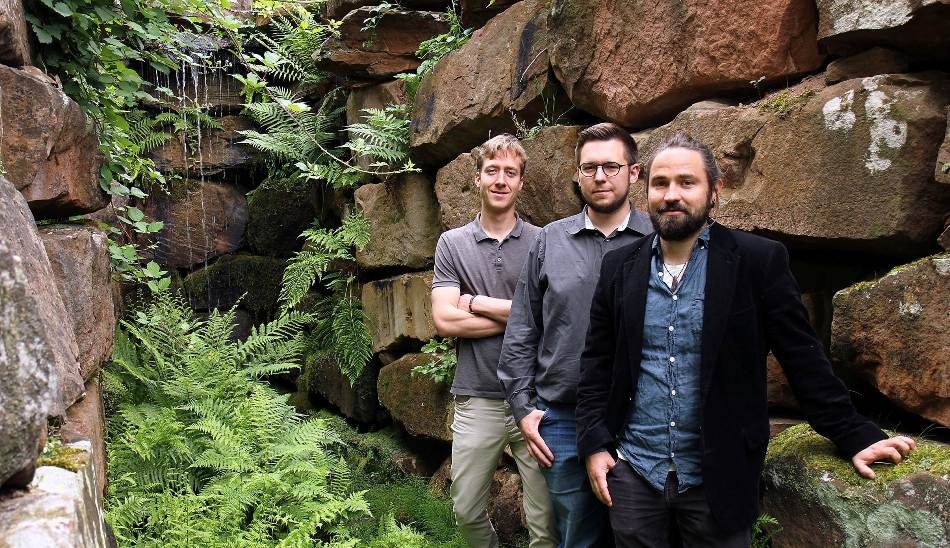Jun 26 2019
Air pollution is growing in a number of cities. It is also becoming warmer and warmer and flooding happens during heavy rain as the surfaces are sealed. Therefore, new theories are needed to ensure that cities remain habitable for their citizens, including additional green spaces that ensure an agreeable climate and keep the air clean. The greening of façades is also crucial.
 The founders (from left to right) Martin Hamp, Björn Stichler, and Dr. Tobias Graf have developed the system for green façades. (Image credit: Koziel/TUK)
The founders (from left to right) Martin Hamp, Björn Stichler, and Dr. Tobias Graf have developed the system for green façades. (Image credit: Koziel/TUK)
A system for green façades that is maintenance-free and, thanks to moss, self-greening, has been created by a start-up of Technische Universität Kaiserslautern (TUK). The founders are commercializing this system via their company "Artificial Ecosystems".
About 400 million years ago, mosses grew on Earth. In contrast to other plants, they do not possess roots. "They filter their nutrients out of the air," says botanist Dr Tobias Graf, who has been investigating these plants for a long time. "Back then, there was a series of volcanic eruptions that released a lot of ash into the atmosphere. Mosses have taken advantage of this to supply themselves with nutrients." Even at present, they filter CO2 and fine dust from the air. They also grow in numerous places in the city — without human involvement, just because the ecological circumstances fit.
The belief was that what is successful in nature should also work when artificially produced, Graf thought. Thus, the idea to form a company was launched. Along with his two colleagues, information electronics technician, business information scientist Björn Stichler and civil engineer Martin Hamp have created a façade that is maintenance-free and self-seeding. They christened their technology BryoSYSTEM. They got the name from the Latin word for moss — Bryophyta.
The smallest unit has a concrete element about 1 m high, 15 cm wide, and just a few centimeters deep. It can be easily fixed to the walls of buildings, for instance. At its top, there is a solar cell, but other energy supply sources can also be possible. On the ground, there is a water tank where the technology is stored and which can be set up in the ground.
For mosses to grow on surfaces, the elements have dedicated structures on which young moss plants can develop ideally. "At the top of the elements there is a semicircular recess through which watering takes place. The bordered grooves ensure that the water is evenly distributed," explains Hamp about the technology. Rainwater captured in a cistern can be used for this purpose.
What is unique: The façade elements do not have to be planted beforehand. The founders pre-treat their façade elements with an exclusive mixture to help the mosses establish themselves more rapidly. Spores of mosses can be found everywhere in the air. These can easily settle and find suitable growth environments.
The plants are accustomed to the prevailing climate and do not have to adapt. In addition, mosses do not require any further cost-intensive care such as plant protection or pruning - which is a disadvantage of previous façade greening."
Dr Tobias Graf, Botanist
Compared to other plants that are presently used for façade greening, mosses stay green throughout the year. "They're most comfortable at cooler temperatures," he continues. "When it gets too hot in summer, they fall into a kind of sleep, a dormancy."
The BryoSYSTEM has several sensors which track humidity and other environmental factors and transmit such data to a measuring device. "Using an algorithm, this device adjusts plant nutrition according to weather conditions," says Stichler. "Moreover, such data is exciting for future smart city concepts," he continues.
"For example, we want to find out how much CO2 and fine dust the plants absorb. Cities that use the system in public buildings, for example, could use these figures for their advertising." With their technology, they not only help to neutralize air pollution in cities, but also boost biodiversity. Furthermore, mosses can serve as noise protection and rain storage. In the future, the founders are also envisaging moss walls in underground stations and tunnels.
If they are irradiated with an artificial light source, they can also live there and help, for example, to clean the air of pollutants.
Dr Tobias Graf, Botanist, TUK
A patent has been applied by the founders for their system. On their pursuit for autonomy, they are supported by their two mentors, Professor Dr Marcus Rühl, who studies construction and design at Hochschule (HS) Kaiserslautern, and Professor Dr Burkard Büdel, emeritus, who spent a number of years researching lichens and mosses at Technische Universität Kaiserslautern and is an internationally distinguished expert in this field.
Furthermore, the start-up office of TUK and HS as well as the Bito-Campus start-up center in Meisenheim support the fledgling company. They have also received a twelve-month Exist Scholarship from the Federal Ministry of Economics totaling to about 145,000 euros.
The founders are seeking for partners and first customers to accomplish pilot projects. This year, they received first place in the Rhineland-Palatinate ideas competition. They are also hunting for employees who are dedicated to making cities greener.